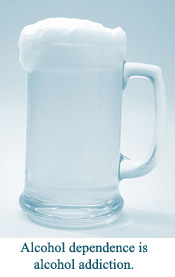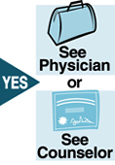Alcohol ProblemsAlcohol problems include alcohol abuse and/or dependence. Alcohol abuse is the repeated use of alcohol that results in daily living problems. Examples include:
Alcohol dependence, also known as alcoholism, is a disease. It includes four symptoms:
|
 |
A tendency to become alcoholic is increased if family members are alcoholic. Men and women are about four times more likely to become alcoholic if one of their parents was and ten times more likely if both parents were. Environmental factors also play a role. For example, the more a person drinks, the greater the risk. Also, being able to consume a lot of alcohol (having a high tolerance) is a risk factor, not a safeguard, for alcoholism.
Alcoholism affects the alcoholic’s physical health, emotional well-being and behavior. Alcohol abuse and/or dependence can develop in several ways:
|
|
Drinking in excess on an almost daily basis |
|
|
Drinking a lot at certain times, such as partying every weekend |
|
|
Binge drinking after long periods of not drinking |
|
|
Drinking infrequently, but with loss of control over drinking and/or behavior problems while drinking |
|
|
Drinking which in some way has a negative impact on the person who drinks and other people |
Physical Effects of Alcohol
|
|
Can impair mental/physical reflexes |
|
|
Can increase the risk of diseases, such as cancer of the brain, tongue, mouth, esophagus, larynx, liver and bladder, cirrhosis of the liver and hepatitis, ulcers, gastritis and brain damage when used heavily. It can also cause heart and blood pressure problems. |
|
|
Can lead to malnutrition |
|
|
Is known to cause birth defects |
Emotional and Behavioral Effects of Alcohol
|
|
May cause someone to do things they might not do otherwise, such as driving at dangerous speeds or other daredevil acts. |
|
|
May result in anger, violent behavior or depression which can intensify as more alcohol is consumed. Can result in suicide or physical and sexual assaults. |
|
|
May result in memory loss, the ability to concentrate and problems in other intellectual functions. |
|
|
Can make family life chaotic. The divorce rate is seven times higher among alcoholics. Also, children of alcoholics often have emotional problems lasting into adulthood. |
|
|
Often results in decreased work or class attendance and performance, as well as, problems in dealing with co-workers or other students. |
Treatment
|
|
Self-help groups such as:
|
|
|
Alcohol treatment programs. Many types
exist:
|
Two prescription medicines are available to help in treatment. One called Naltrexone, blocks the craving for alcohol and the pleasure of getting high. Another one, called Antabuse, causes physical reactions, such as vomiting when drinking alcohol. Antabuse is rarely used.
Questions to Ask
|
 |
|
|
|
|
 |
|
|
|
|
 |
|
|
|
|
 |
|
|
|
|
 |
|
|
|
|
 |
|
|
|
|
 |
|
|
|
|
 |
|
|
|
|
|
Self-Help
|
|
Cut down on partying. |
|
|
Know your limit and stick to it or don’t drink any alcohol. |
|
|
Drink slowly. You are apt to drink less. |
|
|
Pour less alcohol and more mixer in each drink. |
|
|
Alternate an alcoholic beverage with a non-alcoholic one. |
|
|
Eat when you drink. Food helps to slow alcohol absorption. |
|
|
Don’t have any alcohol if you are pregnant. |
|
|
Talk to people who will listen to your feelings and concerns without putting you down. |
|
|
Find ways to calm yourself other than with alcohol. Examples include hobbies, relaxation exercises, physical activities, music, movies, etc. |
|
|
Realize that if you are a parent, you are a role model for your children. They learn what they see. When you drink, do so responsibly. |
|
|
Don’t mix drinking with driving, drugs or operating machines. Doing so can be fatal. |
|
|
Don’t rely on coffee or fresh air to make you sober. Even though you see these things done on TV, they won’t make a person sober. |
|
|
Use the Now Awareness Technique. This technique was developed by a Twelve Step program and is used to rid yourself of thoughts about drinking. When a desire to drink comes to mind, distract yourself by saying out loud or silently: “Now I am aware of __________,” and finish the sentence by naming any objects that you can see. For example, if you were sitting at your desk, you might say: “Now I am aware of the monitor;” “Now I am aware of the clock,” etc. Keep this up until your urge to drink passes. |
|
|
Contact your Employee Assistance Program (EAP) at work or student counseling center for information and other suggestions. |
What You Can Do for a Friend or Relative
|
|
Encourage them to seek professional help and/or join a support group. Reassure them of your support. |
|
|
Have phone numbers handy for places or people they can call to get help. |
|
|
Attend a support group with or without your friend or relative to
learn about alcoholism. Examples are:
|
|
|
Avoid codependent behavior. Do not lie or otherwise make excuses for your friend or relative’s problems that arise from their drinking. Seek help if you find that you are behaving this way. |
|
|
Don’t allow your friend or relative to drive when they have been drinking. Insist on driving yourself, if you are sober, or find another safe passage home. Refuse to be a passenger of someone who has been drinking. |
|
|
Take the following actions once your friend or relative is getting
help and recovering from alcoholism:
|
